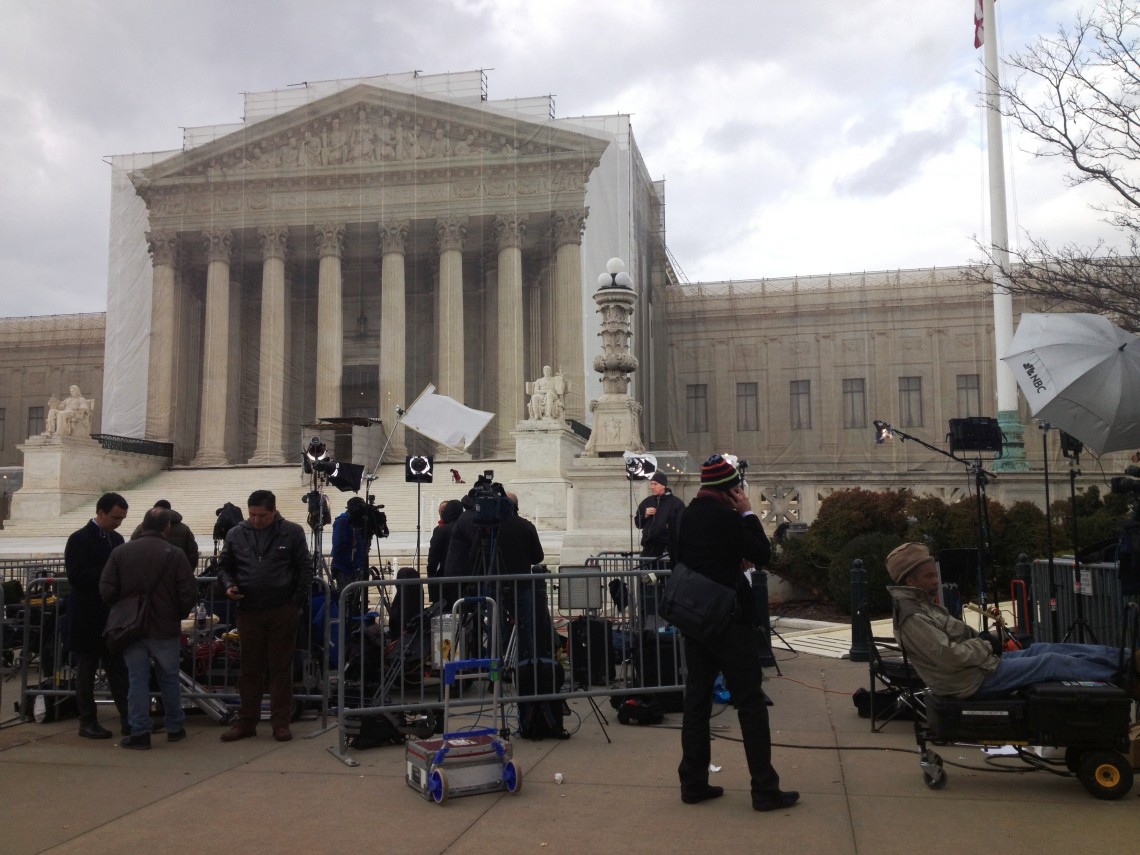I was not supposed to be in the seat I stole inside the press gallery of the United States Supreme Court.
I was a 36-year old intern with unfettered judicial curiosity who spent four weeks working for a television network assigned to cover SCOTUS in the last week of June of 2012.
Let me repeat that: intern, unpaid, on the wrong side of 30.
I was there because I wanted an experience in media I could learn from and report out to the scores of students to whom I teach law and government in Chicago, but what I didn’t expect was that my age would pay off as it did.
When entering the press gallery, an armed security guard looks for either a hard press pass (i.e. legit SCOTUS journalist) or a disposable paper pass (i.e. intern). You are then waved either to the right, into the gallery seats, or to the left. Go right and you’ll get as close as anyone ever gets inside the Court to the justices. Go left and two rows of feeble wooden chairs are relegated behind massive marble (Ionic? Doric?) columns with equally massive obstructed-views and terrible sound.
I had a unique set of circumstances that equated to advantages, relative to the other interns, that made my illicit press access into the fortress that is the Supreme Court different and easier. First, I so clearly looked much older than they did, and therefore likely was either mistaken or “passed” for a Supreme Court advocate or an actual journalist by the guards and secret service. (Perhaps finally the adage “age before beauty” worked in my favor.) I also arrived earlier than the other interns each morning and got a better spot in the press line one must wait in before security ushers press into the gallery. But most importantly, I kept my mouth shut and my head down. The barrage of questions the interns asked anyone and everyone nearby endeared them less and less to the journalists in line or seated near them. Security personnel, who must have Masters degrees in “shushing,” were also not fans of the constant inquiries.
When I arrived, the guard looked at my pass, appeared confused (again, I’m not 22), and gave me no nod. And there was my opportunity.
Would I interpret his bewilderment to mean, “Go to the right. Sit at the adults table, with the pillars of legal reporting, chatting up Jeffrey Toobin, spotting Nina Totenberg’s fancy shoes, Politico, the Washington Post, CNN, and former justices in the general public rows?” Or did I take my seat at the kids’ table where I would no doubt spend 20 minutes listening to the co-eds complain about their summer housing assignments and law school application processes? It being easier to ask forgiveness than permission, I took the security guard’s insouciance as a sign to go right. I took my seat in the press gallery.
I was steeped in Ivy League educations and Supreme Court clerkships, Brooks Brothers and Mont Blanc. Desperate not to be found out and forcibly removed, I kept my head down, ears open and tried not to let my public education show.
Jeffrey Toobin began to chat us up. We were regaled with stories about his impending travels to Asia to promote The Oath. He and Totenberg were regularly “shushed” by security.
Then two journalists from semi-major networks couldn’t remember who replaced Justice O’Connor on the bench. “Was it Kagan or Sotomayor? Or the other way around?” one man asked the other. Wait…what? I couldn’t help myself. I answered (Alito). They thanked me (and, more importantly, didn’t ask to see my hard press pass, or lack thereof).
Sandra Day O’Connor sat directly across from our gallery seats next to Justice John Paul Stevens. Iconic white bob and bow tie? Check, check. Her do-not-mess-with-my-Grutter–decision stone face was not lost on me. (This was the day the post-Grutter affirmative action decision in Fisher v. The University of Texas would likely decide the future of race-conscious college admissions processes.)
To be in the same room with 11 of the 12 living justices was profoundly momentous, special, pinch-worthy, elating, unparalleled, and historic for me. To have a seat—undeserved though it was—inside the Court listening to the majority opinions and dissents on affirmative action, the Voting Rights Act, and same-sex marriage was all the payment this intern could’ve wanted. This happened only twice while I was there, but for both days I got to sit with and observe how the 26 journalists who have hard press passes inside the Supreme Court do what they do.
Oh, and my teaching and curriculum design are better because of it, too.
Cara Gallagher teaches high school in Chicago. Her blog SupremeBystandr, where she reports on the Court from an educator’s perspective for an audience who does not speak legalese, was inspired by this experience.








